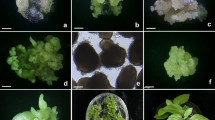Abstract
An efficient plant regeneration system was developed for Hordeum vulgare L. 'Morex' barley, an important United States malting cultivar. The protocol was based on a series of experiments involving the sizes of immature embryos and the culture media. We found that the embryo size is critical for the establishment of embryogenic callus. Smaller embryos (0.5–1.5 mm) showed a much higher ability to produce embryogenic callus capable of regenerating green plants with fewer albinos than did the larger embryos (1.6–3.0 mm). Either 3 mg/l 2,4-dichlorophenoxyacetic acid or dicamba in modified Murashige and Skoog's (MS) medium was optimum for the induction of embryogenic callus. The embryogenic callus maintained high regeneration during six subcultures in the callus induction medium. Efficient shoot regeneration was obtained on modified MS medium containing 0.5–1.0 mg/l 6-benzylaminopurine (BA). Regenerated shoots were rooted on half-strength MS medium containing 0.2 mg/l IBA. Plants were successfully transferred to soil and grown to maturity in the greenhouse. This efficient plant regeneration system provides a foundation for generating transgenic plants of this important barley cultivar.



Similar content being viewed by others
Abbreviations
- 2,4-D :
-
2, 4-Dichlorophenoxyacetic acid
- BA :
-
6-Benzylaminopurine
- CIM :
-
Callus induction medium
- IBA :
-
Indole butyric acid
- IE :
-
Immature embryo
- KT :
-
Kinetin
- LSD :
-
Least significance difference
- MS :
-
Murashige and Skoog medium
- SIM :
-
Shoot induction medium
References
Bebeli P, Karp A, Kaltsikes PJ (1988) Plant regeneration and somaclonal variation from cultured immature embryos of sister lines of rye and triticale differing in their content of heterochromatin. Theor Appl Genet 75:929–936
Bregitzer P, Campbell R (2001) Genetic markers associated with green and albino plant regeneration from embryogenic barley callus. Crop Sci 41:173–179
Bregitzer P, Poulson M (1995) Agronomic performance of barley lines derived from tissue culture. Crop Sci 35:1144–1148
Bregitzer P, Dahleen LS, Campbell RD (1998) Enhancement of plant regeneration from embryogenic callus of commercial barley cultivars. Plant Cell Rep 17:941–945
Castillo AM, Egana B, Sanz JM, Cistue L (1998) Somatic embryogenesis and plant regeneration from barley cultivars grown in Spain. Plant Cell Rep 17:941–945
Cho MJ, Jiang W, Lemaux PG (1998) Transformation of recalcitrant barley cultivars through improvement of regenerability and decreased albinism. Plant Sci 138:229–244
Choi H, Lemaux PG, Cho M (2001) Selection and osmotic treatment exacerbate cytological aberrations in transformed barley (Hordeum vulgare L.). J Plant Physiol 158:935–943
Dahleen L (1999) Donor-plant environment effects on regeneration from barley embryo-derived callus. Crop Sci 39:382–385
Dahleen LS, Bregitzer P (2002) An improved media system for high regeneration rates from barley immature embryo-derived callus cultures of commercial cultivars. Crop Sci 42:934–938
Dahleen LS, Okubara A, Blechl AE (2001) Transgenic approaches to combat fusarium head blight in wheat and barley. Crop Sci 41:628–637
Hayes PM, Castro A, Marquez-Cedillo L, Corey A, Henson C, Jones BL, Kling J, Mather D, Matus I, Rossi C, Sato K (2003) Genetic diversity for quantitatively inherited agronomic and malting quality traits. In: Von Bothmer R, Knupffer H, van Hintum T, Sato K(eds) Diversity in Barley. Elsevier, Amsterdam (in press)
Lu CY, Chandler SF, Vasil IK (1984) Somatic embryogenesis and plant regeneration from cultured immature embryos of rye (Secale cereale L.). J Plant Physiol 115:237–244
Marquez-Cedillo LA, Hayes PM, Kleinhofs A, Legge WG, Rossnagel BG, Sato K, Ullrich SE, Wesenberg DM (2001) QTL analysis of agronomic traits in barley based on the doubled haploid progeny of two elite North American varieties representing different germplasm groups. Theor Appl Genet 103:625–637
Murashige T, Skoog F (1962) A revised medium for rapid growth and bioassays with tobacco tissue culture. Physiol Plant 15:473–497
Sahrawat A, Chand S (2001) High-frequency plant regeneration from coleoptile tissue of indica rice (Oryza sativa L.). In Vitro Cell Dev Biol 37:55–61
Tingay S, McElroy D, Kalla R, Fieg S, Wang M, Thornton S, Brettell R (1997) Agrobacterium tumefaciens-mediated barley transformation. Plant J 11:1369–1376
Trifonova A, Madsen S, Olesen A (2001) Agrobacterium-mediated transgene delivery and integration into barley under a range of in vitro culture conditions. Plant Sci 161:871–880
Wan Y, Lemaux PG (1994) Generation of large number of independently transformed fertile barley plants. Plant Physiol 104:37–48
Wang Z, Lehmann D, Bell J, Hopkins A (2002) Development of an efficient plant regeneration system for Russian wildrye (Psathyrostachys juncea). Plant Cell Rep 20:797–801
Ward K, Jordan M (2001) Callus formation and plant regeneration from immature and mature embryos of rye (Secale cereale L.). In Vitro Cell Dev Biol 37:361–368
Yu Y, Tomkins JP, Waugh R, Frisch DA, Kudrna D, Kleinhofs A, Brueggeman RS, Muehlbauer GJ, Wise RP, Wing A (2000) A bacterial artificial chromosome library for barley (Hordeum vulgare L.) and the identification of clones containing putative resistance genes. Theor Appl Genet 101:1093–1099
Acknowledgements
We thank Kim Hummer and Barbara Reed for critical reading of the manuscript. This research was supported by the National Science Foundation (grant no. DBI-0110124 ) and by the Oregon Agricultural Experiment Station. Oregon Agricultural Experiment Station technical paper no. 11927.
Author information
Authors and Affiliations
Corresponding author
Additional information
Communicated by K.K. Kamo
Rights and permissions
About this article
Cite this article
Chang, Y., von Zitzewitz, J., Hayes, P.M. et al. High frequency plant regeneration from immature embryos of an elite barley cultivar (Hordeum vulgare L. cv. Morex). Plant Cell Rep 21, 733–738 (2003). https://doi.org/10.1007/s00299-003-0607-8
Received:
Revised:
Accepted:
Published:
Issue Date:
DOI: https://doi.org/10.1007/s00299-003-0607-8




